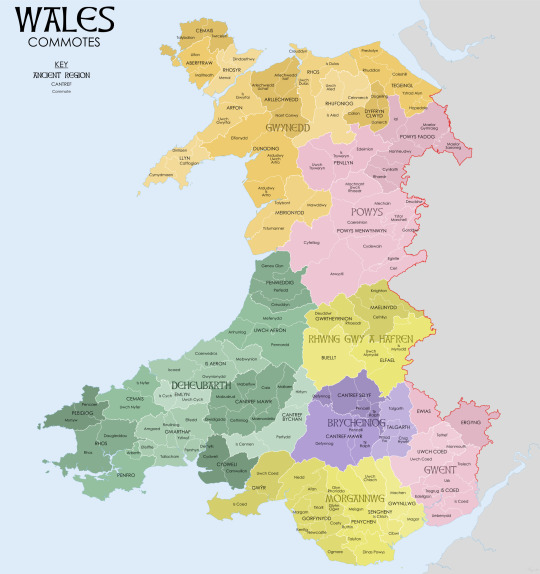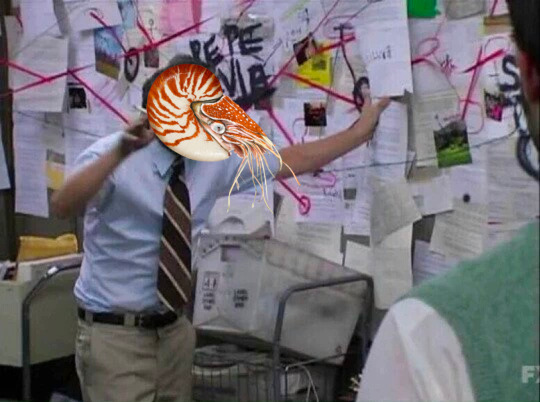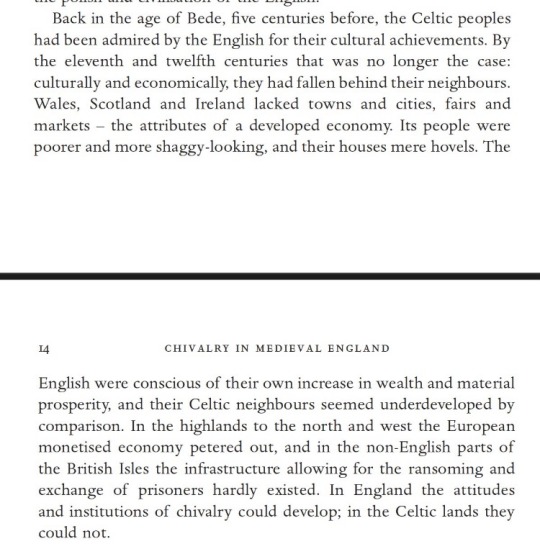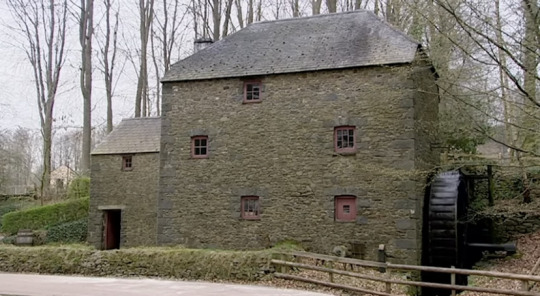#welsh medieval history
Explore tagged Tumblr posts
Text
Helo, helo, helo! Getting this marriage law edition out quickly as I am ON THE BEVS TONIGHT (wine. I've had a horrid day ffrindiau. I need this.)

So! Last time we spoke about Amobyr and Cowyll, this time it's Gwaddol and Agweddi!



So, Gwaddol is relatively simple but it is also referred to as Agweddi even though they are VERY different. Gwaddol is the right for a daughter to have her share of her father's movables (so cutlery, livestock, plates, furniture, stuff like that.) by dowry provision.
The word itself translates to 'gift, distribution, division,' which neatly tells you exactly what that particular law was about. It's VERY rare in law texts of the time because it was just usually lumped in with 'Agweddi.' According to certain texts (Peniarth MS. 28) a man who failed to rebut a charge of rape on a woman who was walking alone was 'required to pay her gwaddol,' which suggests that the gwaddol in that case was paid as a mark of a woman's chastity. (However, I would argue this particular case is much more likely to be a case of the law being classed under Cowyll rather than Gwaddol but I am not an academic.)
Next, Agweddi!
This one is slightly more fun! Agweddi is perhaps the most complicated law of the bunch and - as discussed - is somewhat of an umbrella term for other laws.
Now, Agweddi is, delightedly, a dowry payable to a wife whether she was a virgin or not by a husband when the marriage was consummated with sureties being given for its payment before marriage. Always good to get some assurances. You'd also get it for rape.
The agweddi was mentioned in The Mabinogion. The Dream of Macsen Wledig mentions it saying, 'Early the next day the maiden [Elen] claimed her maiden fee since he had found her to be a virgin.' Way to go, Macsen. As well as this, it's also found in Culhwch and Olwen: 'They [Culhwch, Bedwyr, Cai, etc.] said, "Ysbadden Pencawr, give us your daughter in exchange for her dowry and her maiden-fee to you and her two kinswomen."'
So, it's a BIG FUCKIN DEAL. It's perhaps what I would classify as being the 'main law' or your big-hitter. Certainly, that one and the Cowyll are, arguably, the most important. Agweddi was fixed in terms of how much each class had to pay, like the Amobyr and the Cowyll, and there may have been a marked difference between if your family was giving you away (like in 'The Dream of Macsen Wledig' and 'Culhwch and Olwen') or if you did a Gwenllian ferch Gruffudd ap Cynan and eloped with your bae. How much by isn't clear. It's not that it was seen as lesser but it might have been more uncouth, as it were, to be eloping. For more light on the matter, the Dimetian Code (South Wales) says that the woman who eloped WAS allowed the same amount as a lady was given away l, but in others, it says that it WAS fixed so I think it has more to do with status.
Now, also, if you were found to be in contempt of agweddi (I.e. you'd fuckin BANGED BEFORE MARRIAGE) you'd have a (slightly hilarious) punishment. Your husband would call together all the marriage guests, and the candles would be lit and the woman had to take an oath that she was pure.
Now, whether she was seen to be chaste depended partly on her age. If she was twelve (which was the age a girl became a woman under Welsh law) she was automatically seen as chaste and the marriage was coolie beans. If she was mature however, then she had to be like 'I'm a virgin dw' to five people which included her mum, dad, brothers, sisters, and grandparents as well as other village members.
But if she denied that she was pure then she had all her clothes cut to her hips and was made to hold the welll-greased tail of a steer which was thrust into the hole of a house door. You might be asking 'Well, Sarah what the fuck were the Welsh thinking?' And, in truth, my friend, I cannot say. Please, don't ask me why this was an appropriate punishment. I haven't a fuckin clue because it is essentially a bucking bronco in execution.
Two men then prodded the steer and the woman had to attempt to hold onto the animal. If she was successful in doing so then the steer was part of her Agweddi. If she wasn't then she had to be content with the grease on her hands.
Also, cohabitation with a man still entitled you to Agweddi as it was seen as being the equivalent to the first three days of marriage. So, y'know, you've just tracked yourself to a marriage. The woman cohabiting had to claim her Agweddi within the first seven days of marriage or, if not, then she had to wait a year and a day from when she and her beau began cohabiting together.
Now, obviously this is just a short thing and I apologise if it's bad. I want you to know that that we have like three fuckin law books about this stuff because, even though they are know as 'The Laws of Hywel Dda' other rules expanded and adapted them for their own needs.
Seriously, I'm not joking when I say this but the Codes have different things about how much a cat was worth. A CAT. There's an excellent video by Cambrian Chronicles about it that I shall link for u.
Okay, hwyl fawr!!! Off to DRINK cider. Thinking about doing a short yelly thing about Welsh Poetry* next before the final episode of Marriage Laws drops next Sunday.
*it's so I can yap about Hywel ab Owain Gwynedd again. It's my enrichment.
Quotes from the Mabinogion are from the 2007 translated by Sioned Davies.
#mabinogion#the mabinogion#welsh myth#welsh mythology#arthuriana#the laws of hywel dda#welsh marriage laws#welsh history#the dream of macsen wledig#culhwch and olwen#culhwch ac olwen#welsh medieval history#cambrian chronicles#ngl this is not my best work#hanes gymraeg#laws about women#arthurian legend#celtic laws#welsh laws#welsh wedding laws
18 notes
·
View notes
Text

Guinevere and Iseult: Cartoon for Stained Glass, William Morris. 1862.
#art#aesthetic#art history#historical fashion#historical art#women in art#victorian#women#pseudo medieval art#medieval art#1860s art#medieval aesthetic#guinevere#iseult#Isolde#arthurian legend#medieval fashion#1860s#william morris#stained glass#tristan and iseult#Arthur and Guinevere#king arthur#medieval legend#french medieval#welsh medieval#Irish medieval#engraving#cartoon#fashion
2K notes
·
View notes
Text

King Arthur. Illustration by an unknown artist from a 15th century Welsh manuscript of Geoffrey of Monmouth's History of the Kings of Britain (Historia Regum Britanniae). Now in the National Library of Wales, Aberystwyth. Photo credit: National Library of Wales.
#art#art history#Middle Ages#medieval#medieval art#King Arthur#Arthurian legend#Arthuriana#illustration#illuminated manuscript#manuscript illumination#Geoffrey of Monmouth#Welsh art#15th century art#National Library of Wales
327 notes
·
View notes
Text
With the importance of Cattle as a measure of wealth in Celtic, and especially, Welsh society, can you imagine the Knights of the Round Table being obsessed with cows? Raiding for cows, exchanging cows, questing for cows, King Arthur and Morgan le Fay showing how powerful and influential they are by having a whole load of cows at their strongholds, etc.
#arthuriana#arthurian mythology#welsh culture#celtic culture#medieval history#knights of the round table#cattle#pastoral society#welsh history#king arthur#morgan le fay#arthurian legends#arthurian legend#arthurian literature
45 notes
·
View notes
Text










Women’s History Meme || Mistresses (4/10) ↬ Nest ferch Rhys (c. 1085 – c. 1136)
She was the daughter of one king and the lover of another; the matriarch of a powerful dynasty and the cause of conflict and war. While most of her countrywomen lived out their lives in quiet obscurity, Nest, Princess of Dyfed, became a legend. She lived through one of the most exciting and dynamic periods of Welsh and English history, and was herself an influence upon its events. Her life provides a rare opportunity to explore the role of women in early Wales and the impact upon it of the Norman invaders. She was born into an extraordinary time. Her father, Rhys ap Tewdwr, was king of Deheubarth, the kingdom which extended over south-west Wales, and enjoyed considerable influence throughout all Wales. Yet he had very nearly not become king at all, and throughout his reign he had the strange distinction of being the only king in Wales to hold his kingdom undisturbed by the new neighbours who were occupying England. He had become king in the early years of the Norman Conquest of England, and survived through diplomacy and the policy of William the Conqueror, but on the death of William in 1087, Norman policy changed. The new king of England, William Rufus, needed to secure the loyalty of his aristocracy with land grants and promises of booty. Casting aside the treaty forged by Rhys and his father, he allowed his barons to invade the whole of Wales. Nest, perhaps still a young child, lost her father in battle. Her brother, Gruffudd, fled into exile in Ireland, while Nest fell into the hands of the new lords of south Wales. Up to this point, she must have expected her life to follow the usual pattern for Welsh women of royal blood – marriage to an ally of her father, and a life travelling with her husband’s entourage and bearing his children. The fall of Rhys changed all of this. Her captors, the earl of Shrewsbury and his son, Arnulf, the new earl of Pembroke, probably sent her into their English lands to be raised under their power. It was a journey that would determine the rest of her life. — Princess Nest of Wales: Seductress of the English by Kari Maund
#women's history meme#nest ferch rhys#medieval#welsh history#english history#european history#women's history#history#nanshe's graphics
66 notes
·
View notes
Text

Day 26: Gwenllian ferch Gruffydd. She was the daughter of Gruffydd ap Cynan, king of Gwynedd, and married the prince of Deheubarth. While her husband was away consolidating alliances, she stepped up to defend her country against Norman raiders. She led an army into battle, but was captured and beheaded along with two of her sons.
#grayjoytober2024#gwenllian ferch gruffydd#kingdom of deheubarth#historical women#warrior women#history art#traditional art#medieval wales#welsh history#welsh tag#12th century#inktober 2024#inktober#drawtober 2024#drawtober
22 notes
·
View notes
Text
Witchcraft in Wales

Only five people were found guilty and hanged for witchcraft in Wales, in comparison to the estimated 500 executions in England and somewhere between 3,000 and 4,000 in Scotland.
There was a unique outlook on witchcraft in early modern Wales. For centuries Wales has been considered as a land of magic and the supernatural. The English sometimes travelled into Wales in search for soothsayers and enchanters.
There were fears of witchcraft and black magic in Wales however, but accusations played out differently among communities. Additionally, there was a reliance of soothsayers and wise women or ‘healers’, meaning that ‘magic’ was less likely to be brought to the attention of the court.
There are some similarities between Welsh women and descriptions of witches in literature like the Malleus Maleficarum. They included appearance, unreformed religion, and the reliance on charms to heal. Some researchers theorised that the traditional black hat of the Welsh woman inspired the wide-brimmed hat of the fairy tale witch.
source: Mari Ellis Dunning, Aberystwyth University
#witchcraft#witches#welsh witch#welsh witchcraft#medieval history#early modern history#history#history buff#wicca#welsh wiccan#welsh wicca#wiccablr#paganism#celtic paganism#welsh paganism#folklore#welsh folklore#welsh history#medieval wales#grimoire#book of shadows
31 notes
·
View notes
Text
This video has taught me just how complicated sourcing can be and how easily claims can become misinformation taken as fact. My ability to research and source feels so incredibly inferior. Its a good watch.
#sourcing#resources#research#youtube#I feel i should strive to be MUCH better#welsh history#wales#welsh#henry vii#house of tudor#british#medieval history#Cadwaladr#red dragon#flag of wales
50 notes
·
View notes
Text
Elphael: What's In a Name?
Earlier today, my esteemed comrade @the-unkindled-queen made a post wondering about the etymology of Elphael, Brace of the Haligtree. My initial digging turned up a few Reddit comments where the general consensus was that Elphael has its roots (ha) in Hebrew linguistics, with one interpretation being "Family of God" and another being "Work of God":


Now as a linguist and Bible scholar, I think these are awesome. I love seeing all the languages and cultures that these games draw inspiration from, and the Hebrew connection is a neat contrast with the Haligtree itself, which is linguistically Welsh. Additionally, the connection to Abrahamic faith and Hebrew words for people and acts of God is a nice throughline for the way the game portrays Miquella and St Trina as Messianic protectors of the sick and poor. Add in the spiritual atmosphere of Elphael and the Haligtree (prayer rooms, mausoleums, and altar-like statues of Miquella and Malenia abound), and it's a very pleasing little theory.
Soulsborne and especially Elden Ring borrow heavily from Welsh for names and whatnot (like the aforementioned Haligtree), and out of idle curiosity I began to wonder if there was any basis whatsoever for an alternative theory linking Elphael's name to Welsh. My only reasons for going down this path were the vaguely Celtic sound of the name and the fact that the Haligtree proper has a Welsh name. I didn't find anything like this during the search that led me to the Hebrew theories, and plugging various fragmentations of "Elphael" into a Welsh->English translator didn't spit out anything of value. I was about to throw in the towel when I did what I probably should have done before faffing about with the translator and just searched "Elphael Welsh."
And oh golly do we have ourselves an Elphael. Or an Elfael.
Welcome to the infinitely confusing world of medieval Welsh history.
Medieval Wales was divided into several regions, called cantrefi. Each cantref was further divided into several territories called commotes. The cantrefi are pictured below. We're mostly concerned with the central yellow one, Rhwng Gwy a Hafren, but also remember Gwynedd. It's in orange up top.

But that's for later. What we care about right now is the cantref of Rhwng Gwy a Hafren, which lies between the rivers Wye and Severn. This cantref is shown in detail below and is home to the commote of Elfael, shown in green. Also take note of Maelienydd and Buellt. They're light blue and yellow respectively, and we're going to need them later.

The history of Elfael is short and confusing, as one can expect from a fiefdom straddling the English-Welsh border during the post-Roman and post-Norman Conquest years. It didn't exist as a political entity for very long (it was only independent from 1155ish to about 1215 before dissolving completely in 1309), and changed hands often during its lifetime.
Our story begins with a man named Elystan Glodrydd, Prince of Buellt. He lived from 950 to 1010 CE, and at some point during his later life he conquered a territory called Ferlix, which was composed of Elfael and Maelienydd. When Elystan died, rulership of Buellt (Ferlix included) passed to his son Cadwgan, and then to Cadwgan's son Idnerth when he died.
Idnerth's reign is remarkable because he's the guy who lost Buellt. An Anglo-Norman noble, Philip De Braose, had conquered basically all the land between the Wye and Severn, which of course included Buellt. For some reason, at the conclusion of his conquest De Braose gave Ferlix back to Idnerth, but kept Buellt for himself. The end result being that Idnerth had gotten kicked out of his grandpa's commote and into what had originally been a conquered vassal territory. Once Idnerth died (presumably in shame), Ferlix went to his son, a man with the astoundingly awesome name of Madog. During this time, the Anarchy was starting.
The Anarchy was a civil war in Britain from 1138 to 1153. King Henry I died in 1135, and his heiress, the Empress Matilda, had many enemies who didn't want her to take the throne. In 1130, a castle had been built in southern Ferlix by one of these enemies, an Anglo-Norman named Pain FitzJohn, Sheriff of Hereford. This is the actual best name in this story. Pain FitzJohn is a fucking badass name. This castle, which was of course called Pain's Castle, was acquired by Madog in 1135 under foggy pretenses. It's likely that Pain wanted Madog's protection from Matilda, but we're not sure.
Old Madog knew that getting a castle called Pain's Castle was an achievement that couldn't be topped, and proceeded to die at age 65 in 1140, secure in the knowledge that he was better than Idnerth. He left five sons, who bucked the trend of going to war for their dead dad's land by dividing Ferlix amongst themselves. Unfortunately for them, this is when the Anarchy caught up with them. Another Norman lord, Hugh De Mortimer, invaded Ferlix in 1142. Two of Madog's sons (Hywel and another Cadwgan) were killed, and in 1146 De Mortimer killed a third son, Maredudd, in the process of capturing Pain's Castle. In 1155, Matilda's son Henry II took the throne of England, and when Hugh De Mortimer protested, Henry kicked him out of Ferlix. This left Madog's two surviving sons, Einion Clud and Cadwallon, to pick up the pieces. These guys hated each other, and neither brother could stomach ruling in consort with the other. But for some reason, they didn't kill each other, instead dividing Ferlix again in two. Cadwallon got the northern part, which came to be called Maelienydd, and Einion Clud got the southern part, which was called Elfael.
Einion Clud and Cadwallon still hated each other, and their realms were openly hostile, each brother still believing he was entitled to sole rule of all that had once been Ferlix. (Again, why didn't they just fight to the death like every other medieval family?) Things came to a head in 1160, when Cadwallon kidnapped Einion Clud and sent him in chains to Owain Gwynedd, the aptly-named King of Gwynedd, who in turn pawned him off on King Henry II. Eventually, Einion Clud either escaped or was released. It's not certain which of these occurred, but what is certain is that by 1165, Einion Clud was once again ruling Elfael, and at the Battle of Corwen the two brothers fought together against King Henry under the leadership of Owain Gwynedd. Politics are fucking weird.
There would be no happy ending, however. Hugh De Mortimer's son Roger was swearing revenge on his father's enemies. You might take this to mean King Henry, who kicked Hugh De Mortimer out of Ferlix in 1155, but no, Roger was actually a big fan of Henry II and had fought for the King during the Revolt of 1173. No, Roger wanted revenge on the guys who ruled Ferlix after his dad got yanked. The timeline here is a bit weird, but what's certain is that Roger De Mortimer killed Cadwallon in 1179. He also killed Einion Clud, but I wasn't able to find out when. I found a source saying that Roger killed Einion Clud after his father died, but Hugh De Mortimer died in 1181 and my reading on Cadwallon says that he was the prince of both Maelienydd and Elfael at the time of his death, which would only be possible if Einion Clud died before 1179. In fact, Cadwallon is said to have been ambushed by Roger's men in Elfael.
Anyway, that's all the history we care about for our purposes. Maybe I'm reading too much into things, but the fact that medieval Wales has the Lord of Elfael getting kidnapped by his brother seems a bit on the nose.

In Welsh history, the Anarchy leaves three of Madog's sons dead and the survivors are on opposing feudal factions. The Lord of Elfael is kidnapped by his brother.
In Elden Ring, the death of Marika's son sparks the Shattering, turning every remaining demigod against each other. The Lord of Elphael is kidnapped by his brother.
Either Miyazaki and Germ are fucking Super Saiyan level Welsh history scholars, or this is just an absurd coincidence. Either way, it's cool.
(tiny sidenote: this part is DEFINITELY conspiracy, but isn't it funny that our kidnapped lord has a sibling who rules Maelienydd??? Doesn't that sound a bit like... Malenia??? Obviously Malenia doesn't do the kidnapping in ER, but the names line up a bit too well...)
Sorry Niko, this is way more than you bargained for.
#elden ring#wales#welsh history#medieval history#elden ring lore#miquella the unalloyed#mohg the omen#malenia blade of miquella#the shattering#queen marika the eternal
65 notes
·
View notes
Text

Older comic explainer piece on the life of legendary Welsh rebel Gwenllian ferch Gruffydd
2 notes
·
View notes
Text
Kicking my feet and giggling over this:
The website isn't coming until later this year but by the sounds of it, it'll be an amazing resource for articles about Medieval Wales if anybody is interested!!! (Also, I'm sure there are TONNES of Mabinogi and maybe some Arthuriana stuff in it!!!) WOOHOO!!!
#welsh mythology#the mabinogion#welsh myth#mabinogion#the mabinogi#y mabinogi#y mabinogion#welsh folklore#medieval wales#wales#history#arthuriana#cymru#bore da to MEEEEEE#fabulous news ngl#perhaps maybe i can submit some bits#also THATS MY UNI I WENT THERE!!!!!! OH ABERYSTWYTH U LEGEND!!!!!!!!!!#aberystwyth university#dwned magazine
53 notes
·
View notes
Text
8 notes
·
View notes
Text


This just filled me with such rage. Like 2011??!! 2011?
Anyone who wasn’t English was just an uncouth, uncultured munter apparently. The people were more ‘shaggy looking’? what do you even base that on? What research has resulted in that conclusion?
And then “Celtic peoples”, “Celtic neighbours”, as if that makes those three countries uniform and inherently the same
#fuck you pal honestly#both of my parents are Scottish so I am biased#but even so id say this is… Not Great#however you spin it#genuinely floored this is such a late publishing date for that kinda perspective#but it comes up a lot not just for#ordinary people but see also#Henry VII#also brings up the question of the ‘Celticness’ of England#would how much it theoretically is or isn’t even be consistent?#the Anglo-Saxon separatism and exceptionalism is tiring and I want it obliterated#how do you classify these things. what do those terms even really mean#English history#Scottish history#Welsh history#Irish history#history#medieval#early modern#Scotland#Ireland#Wales#england
12 notes
·
View notes
Text
Addendum: On the topic of Cattle-as-Measure-of-Wealth in Welsh society, a certain someone graciously reminded me that other livestock are also on the table and up for grabs, as shown by this rather humorous anecdote from the Welsh Triads:

*(Poor Mark. Not even he can get some bacon - from his own livestock - when Tristan's around)
#king mark#king arthur#sir tristan#sir kay#sir bedivere#arthuriana#welsh mythology#welsh culture#welsh triads#arthurian mythology#arthurian legends#celtic culture#pastoral society#cattle#cattle raiding#livestock#medieval history#welsh history
16 notes
·
View notes
Text


Tales From the Green Valley (2004)
#tales from the green valley#history#welsh#medieval welsh#welsh history#wales#cymru#wales documentary#medieval#medieval history#Jacobite#17th century#17th century house#1600s#1600s fashion#farming#historic aesthetic#historic garden#historic buildings#historical food#historic fashion#archaeology#stuart#english cottage#english countryside#country aesthetic#countryside aesthetic#cottagecore#cottage vibes#cottage garden
48 notes
·
View notes
Text

In 1594 Gwen Ferch Ellis was the first person to be executed for witchcraft in Wales. Like most accused female witches, Gwen was previously known to have carried out healing of sick humans and animals in the town of Landyrnog.
Gwen was accused of having a charm written backward; something that was assumed to be a form of bewitching. Gwen was taken to Flint goal to await trial.
During her trial, Gwen was accused of having murdered a man called Lewis ap John through witchcraft and was subsequently found guilty and executed as a witch.
Unlike in England, there were very few witch trials in Wales, with only five executions having taken place. It has been estimated that 500 executions of accused witches had taken place in England during the Early Modern Period.
#witchcraft#witch#witch trials#witch craze#welsh history#medieval wales#medieval history#historyblr#historian#history student#history lover#history buff#welsh witchcraft#welsh witch#occult history#early modern history#early modern wales#tudor wales#tudor britain
18 notes
·
View notes